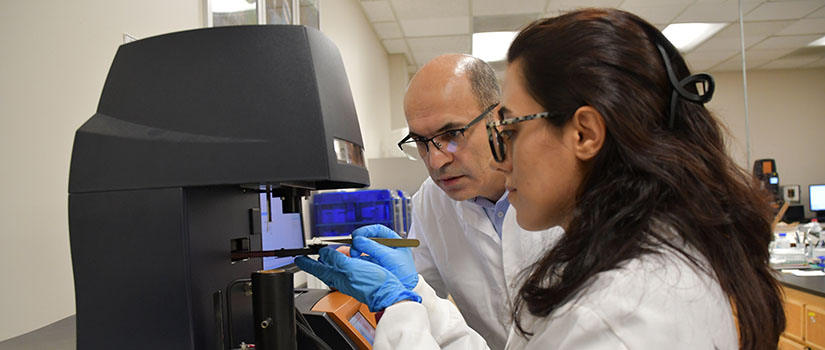Chemical Engineering Assistant Professor Nader Taheri Qazvini has received a National Science Foundation (NSF) CAREER Award to study the molecular interaction of functional materials and their impact on electromagnetic wave absorption. His work will be used in several areas related to national security, such as aviation and control of power grid systems.
The nearly $623,000, five-year NSF-funded project, “Mechanistic Understanding of the Nanoscale Interactions of Structurally Tunable 3D Assemblies of MXenes-Polyelectrolytes,” will allow Taheri Qazvini to study the nanoscale interaction of two-dimensional MXenes, which are ultra-thin electricity conducting layers, with charge-containing polymers. He will use this data to build new materials that can absorb electromagnetic waves.
“By employing interactions between two-dimensional MXenes and polymers, we are aiming to assimilate a three-dimensional structure with properties that can absorb electromagnetic waves and control interference,” Taheri Qazvini says. “The hope is that this will lead to a new class of materials.”
Taheri Qazvini compares this concept to a LEGO tower, where each brick is made of a different material and studying how these bricks are joined together to build a structure with useful properties.
The project will address inefficiencies in electromagnetic shields presently used that rely mainly on reflecting incident waves, which can cause interference with other electronic systems or instruments. New materials that absorb, not reflect, electromagnetic waves would have a wide range of applications, such preventing the interference of aircraft digital instruments, mitigating signal jamming, enhancing the performance of wireless devices, and safeguarding control of electronics for power grid systems.
“With new materials, we can improve efficiency and effectiveness. But what is interesting is that the two-dimensional nature of MXenes presents both opportunities and challenges,” Taheri Qazvini says. “They have great potential, but we have to understand how they interact with other materials and how to manipulate them effectively. That’s where this research comes in.”
Taheri Qazvini explains that his research has even broader implications for society, as the fundamental knowledge obtained could inform the development of other MXene-based hybrids for applications in antimicrobial materials and water treatment.
“As a fan of the wizardry that is going on worldwide in relation to current advances
in material science, I am very proud that Dr. Taheri Qazvini and his team are doing
their beautiful work here at USC,” says Mark Uline, associate professor of chemical engineering and director of the biomedical engineering program. “This CAREER award on MXenes and polyelectrolytes is extremely impressive
scientific research with immense potential applications in the electronics and biomedical
engineering areas.”
Taheri Qazvini’s project will integrate education and outreach by developing curriculum
related to hybrid functional materials and nanoscale interactions, as well as opportunities
for students and STEM teachers to engage in hands-on experiments and workshops. He
will also host a 2D materials symposium to promote collaboration and professional
development among faculty and researchers in South Carolina.
“This research will be a significant contribution to STEM education in South Carolina at all levels,” Taheri Qazvini says. “We want to introduce these principles and how to apply them so that teachers can take them back to their classrooms and inspire the next generation of scientists and engineers. They can use what we have learned and design materials that we haven’t even thought of yet.”
Taheri Qazvini is an assistant professor of chemical engineering and biomedical engineering. His research interests include bio-nano hybrid and biomimetic materials; charge-driven self-assembly; structure-dynamics relations in polymer networks, hydrogels, soft glassy materials and living cells; microfabrication and 3D bioprinting; and tissue engineering and collective cell migration.
